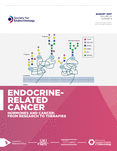Genetics of primary hyperaldosteronism
- 1Department of Clinical and Experimental Medicine, Medical Faculty, Linköping University, Linköping, Sweden
- 2Department of Surgery, County Council of Östergötland, Department of Clinical and Experimental Medicine, Medical Faculty, Linköping University, Linköping, Sweden
- Correspondence should be addressed to O Gimm; Email: oliver.gimm{at}liu.se
-
Figure 1
The renin–angiotensin system and aldosterone production under normal physiologic conditions. The liver continously produces angiotensinogen that is released into the plasma. When the blood pressure and volume decreases, the kidney granular cells start to produce renin, which cleaves angiotensinogen into angiotensin I. Angiotensin I is subsequently cleaved into angiotensin II, which binds to angiotensin II binding receptors (AT1A, AT1B and AT2) on zona glomerulosa cells of the adrenal cortex. This triggers the production of aldosterone. Aldosterone binds to the mineralocorticoid receptor in the kidney. ACE, angiotensinogen.
-
Figure 6
The Wnt/β-catenin signaling pathway is involved in the formation of sporadic APA. Wnt ligands bind to frizzled (Fz) and its coreceptor, LRP5/6, to inhibit the degradation of β-catenin. The stabilized β-catenin translocates into the nucleus, which results in enhanced expression of the transcription factor TCF/LEF1 and ultimately leads to the expression of target genes. In aldosterone-producing adenomas, TCF/LEF1 binds to NURR1/NUR77, which is a trancription factor of CYP11B2.
-
Figure 9
Pathways and channels involved in the biosynthesis of aldosterone. Under physiological conditions, binding of angiotensin II on angiotensin receptor type I (AT1R) activates the voltage-gated Ca2+ channels, which results into influx of Ca2+ ions. AT1R also elicit inositol 1,4,5-trisphosphate receptors (IP3Rs) to release Ca2+ release from the endoplasmic reticulum. Under pathological conditions, genes coding for Na+/K+-ATPase, the potassium channels KCNJ5 or the Ca2+ ATPase and Ca2+ channel CACNA1D are mutated, leading to membrane depolarization and influx of calcium through voltage-gated calcium channel. Mutations in ATP2B3 affect the recycling of Ca2+. However, mutations in L-type Ca2+ channel CACNA1D lead to early opening at lower potential and a sustained activation of the channel, which increases the calcium influx. An increase in the intracellular calcium concentration is found to trigger the production of aldosterone.
- © 2016 Society for Endocrinology












